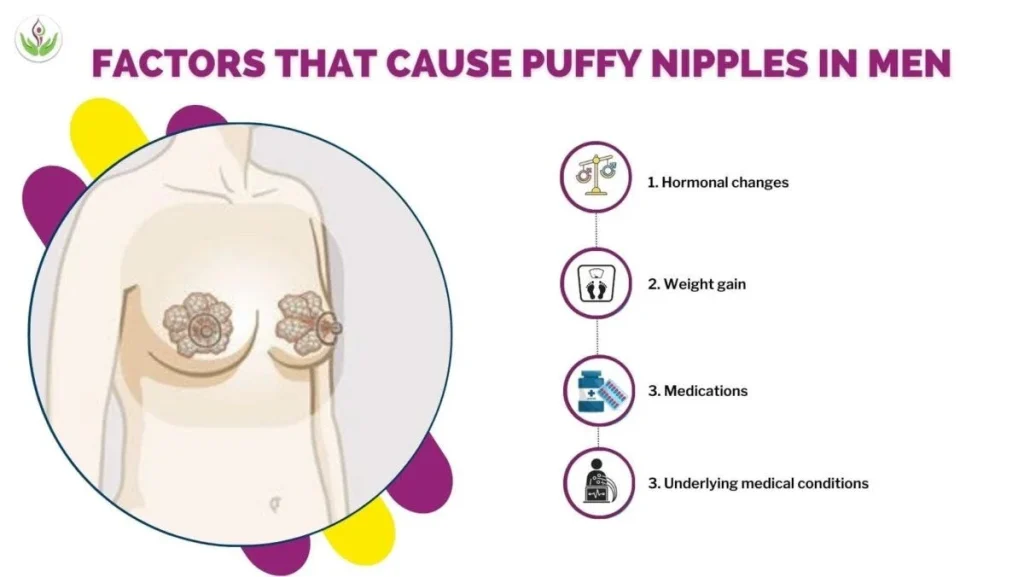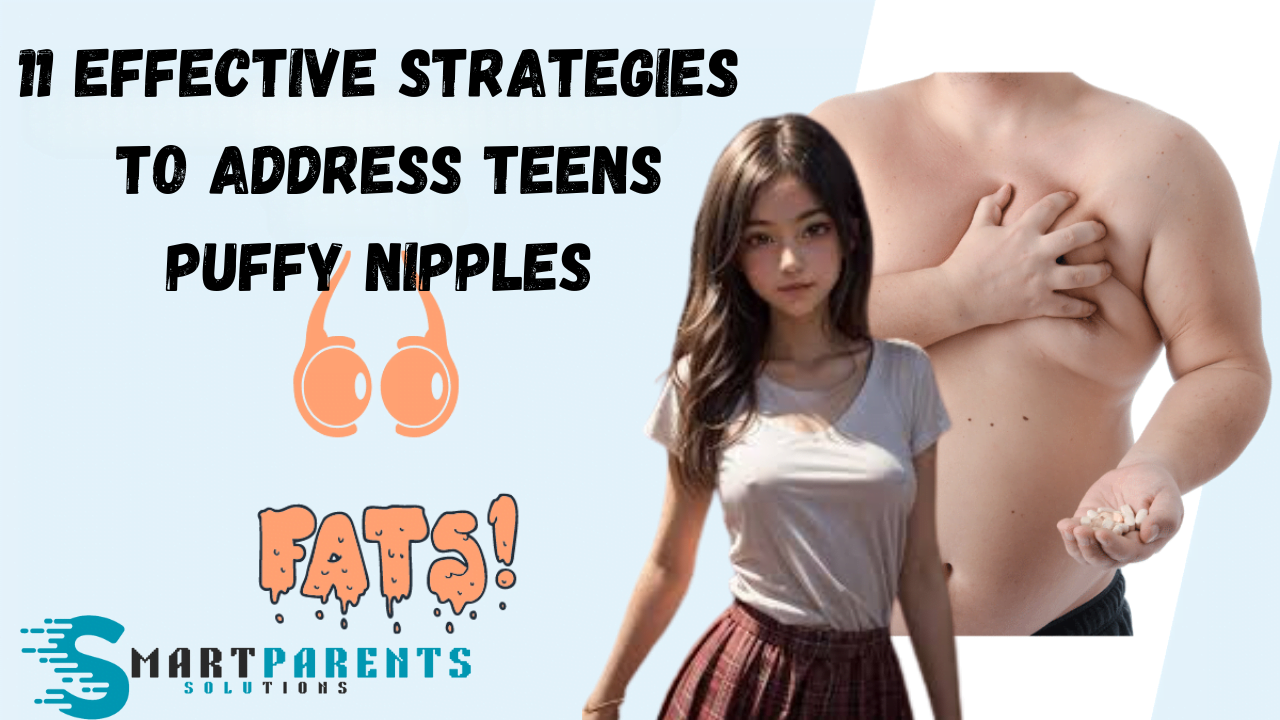Teens experiencing puberty often encounter various changes in their bodies, including concerns about puffy nipples. This extensive guide aims to delve into 11 effective strategies to address teens’ puffy nipples comprehensively, shedding light on the underlying causes, viable treatments, and lifestyle adaptations to manage this phenomenon.
Understanding Teens Puffy Nipples
Defining teens Puffy Nipples

During teenage years boys and girls may experience puffiness involving the nipple and the surrounding area known as areola in both males and females.
Unraveling the Causes
- Hormonal Dynamics: Hormonal changes particularly testosterone and oestrogen level fluctuations are key contributors to puffiness nipples among teenagers.
- Gynecomastia: Gynecomastia, often called puffy nipples during the teenage years, is characterized by a development of breast tissue in males which leads to discomfort and embarrassment among young individuals.
- Influence of Obesity: The higher fat deposits among obese adolescents can cause more estrogen, increasing the probability of developing gynecomastia (puffy nipples) in both sexes.
Addressing Teens Puffy Nipples: Proven Strategies
1. Engage with Healthcare Professionals for Consultation
Initiate an open dialogue with healthcare professionals so as to fully evaluate the root causes of your puffy nipple condition and explore various ways through which you can deal with it.
This approach enables one become proactive about their health.
2. Embrace Lifestyle Modifications for Optimal Health
Incorporate healthy eating, physical fitness and enough sleep as part of a comprehensive approach to wellness among teenagers.
These lifestyle changes promote hormonal balance which eventually minimizes puffy nipples.
3. Help with Psychological Problems and Educational Resources
Help teens to deal with emotional trauma related to bodily alterations such as puffy nipples by giving them coping strategies and necessary information on this issue.
Encourage self-acceptance that makes it easier for people to accept their changing bodies with confidence.
4. Broaden the Spectrum
Providers should engage in a discussion about different treatment alternatives like hormone therapy or surgical procedures tailored to meet specific needs and preferences of each patient.
With such an approach, both satisfaction of patients’ needs and overall health could be addressed at once.
5. Let Teens Know About Normal Body Changes
That Take Place During Puberty Such As Swollen Breasts To Allay Fears and Boost Confidence. Once they understand that these changes are normal, people can become more comfortable in their own skin.
6. Keep Track of How Puffy Nipples Progress and Set up Further Appointments
It involves regular monitoring for the progression of puffy nipples together with any other symptoms and scheduling follow-up appointments as necessary such that adjustments to treatment plans can be made for optimal efficiency and patient satisfaction.
7. Create an Inclusive Environment for Teenagers
Encouraging body positivity and self-love among teenagers for them to see themselves through a different lens other than just physical looks.
By putting the general welfare above everything else they can embolden positive thinking about their bodies and worthiness.
8. Treat Underlying Medical Conditions
Targeted interventions should be employed to identify, treat, or manage health conditions like obesity or hormonal imbalances which contribute to puffy nipples developing.
It is good for someone’s overall well-being when physical health has been optimized better in terms of physiological health over a long period of time.
9. Empower Informed Decision-Making
Informed decisions regarding their own health is an important step in empowering adolescents with detailed information about treatment options including risks, benefits and alternatives.
People are therefore able to take responsibility for their personal health through this participation approach.
10. Facilitate Peer Support Networks
Support networks or online communities should be established in order to enable teenagers to connect with peers and share experiences relating puffy nipples.
Through this unity, belonging becomes an important element which provides emotional support especially during times of transition as well as uncertainty.
11. Promote Holistic Well-Being
Encouraging adolescents to prioritize holistic well-being such as physical, emotional, and social dimensions is key for success in life.
As a result of promoting resilience and confidence; individuals are able to navigate puberty challenges with empowerment and assurance.
Conclusion
It is a common concern among teenagers with hormonal changes during puberty; teens puffy nipples are often associated with them. Use this guide to understand how professional consultations, lifestyle changes, and psychological therapies can help you overcome the problem of teens puffy nipple syndrome as well as facilitate your passage through adolescence with confidence and resilience.
Do not forget that while they may seem embarrassing at times, puffy breasts are temporary effects of teenager age which can be managed with good care and support.
FAQs (Frequently Asked Questions) about Teens Puffy Nipples
Q: Can Puffy Nipples in Teens go Away on their Own?
A: Most often, puffiness of nippless may disappear without any kind of medical help when a child grows older. Still, prolonged concern about this problem suggests that it is necessary to consult the doctor for finding out the reasons and getting relevant assistance or recommendations.
Q: Are there any Natural Remedies for Teens Puffy Nipples?
A: Changing lifestyle like regular physical exercises or balanced diet might be a solution to minimize these symptoms but homeopathic cure is not available. Consequently, it is important for teenagers to consult a healthcare provider for personalized advice and explore the different treatments that are out there.
Q: What are the Potential Complications of Untreated teens Puffy Nipples ?
A: Although puffy nipples themselves are generally benign, untreated underlying conditions such as hormonal imbalances or obesity may lead to complications including consistent psychological distress, aggravation of hormonal disturbances, and self-esteem problems thereby affecting social aspects.
Q: Is it Necessary to do Surgery when a Teenager has Puffy Nipples?
A: In some severe cases of gynecomastia, or persistent nipple protrusion after conservative measures have failed, surgical treatment might be considered including excision of excess glandular tissues. Nevertheless, the decision for undergoing surgery must be made in consultation with healthcare professionals and based on individual patient’s circumstances.
Q: What can Parents do to help Teenagers Who are Worried about having Puffy Nipples?
A: Parents should emotionally support teenagers who may feel traumatized by their condition. Adolescents encountering this puberty challenge could adopt easy conversation between them and their parents where concerns are taken seriously as well as link up with health facilities.
Disclaimer
All information contained herein is provided “as is” for general informational purposes only and should not be taken as a substitute for professional medical advice, diagnosis or treatment. Never disregard professional medical advice or delay seeking medical treatment because of something you have read or accessed through any website including puffy nipples and gynecomastia conditions.
